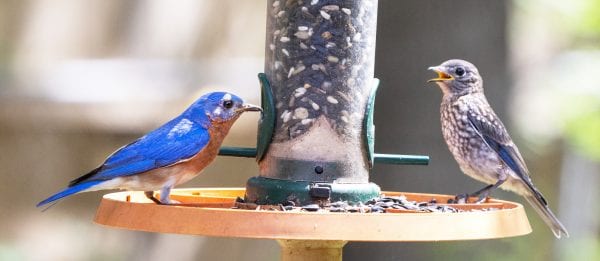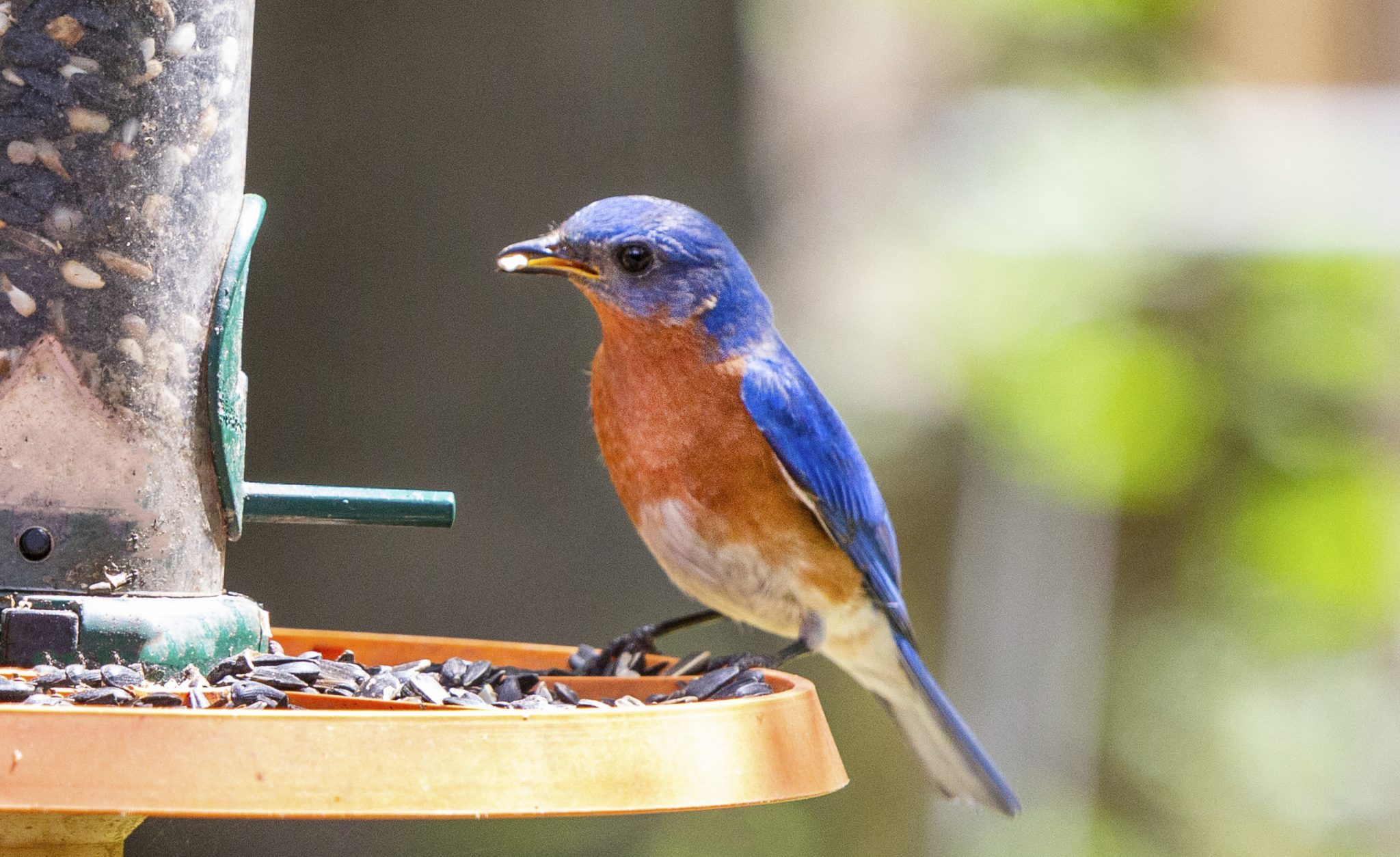Forestry & Wildlife

Eastern bluebirds are a popular species to observe among bird enthusiast and homeowners. Preferring open areas, eastern bluebirds are often seen along roadsides, parks, and yards. Understanding the eastern bluebirds life history and habitat needs is an important step in helping and attracting these beautiful birds to your yard.
The early American settlers called it the blue robin because of its rust-colored breast and blue back and tail. Today, we call it the eastern bluebird. These birds get their namesake by this vibrant coloration on males. However females are a grayish-blue with duller rust- colored breast. Observing this beautiful bird can bring hours of enjoyment. It is easily attracted to homes and surrounding open areas when nesting boxes are correctly constructed and properly placed. Youth organizations and school classes can build and maintain bluebird boxes for educational and money-making projects.
Life History
The bluebird, like the robin, prefers open areas such as roadsides, cutover woodlands, old orchards, parks, and yards in cities and towns. In these areas, the bluebird tries to find a hollow tree (cavity tree) in which to build a loosely woven nest of grasses.
These cavities are often hard to find because nonnative species, such as the house sparrow and starling, also use cavities for nesting. These exotic species are very aggressive and take cavities or boxes bluebirds could use or destroy occupied nests. Fortunately, the bluebird will also use human-made cavities, such as boxes, for nesting. Build the boxes to prevent larger birds, such as starlings, from using them.
Normally bluebirds produce two to three broods per year in Alabama. The female begins the first nest in mid-April. She lays one light blue egg per day for about 4 to 6 days. The female incubates the eggs for about 12 days. Soon after hatching, the young bluebirds begin sprouting feathers. At this time, bluebirds have a gray back and spotted white breast, with only a hint of blue on their wings and tail. Male bluebirds will not get their full color until after 1 year of life. Young birds remain in the nest for about 15 days after hatching.
The male is in charge of the young bluebirds when they leave the nest. He feeds them and teaches them how to find food to feed themselves. He continues this training phase for several days after they leave the nest. While the male is busy with the fledglings, the female remodels the old nest or builds a new one for a second brood.
In the yard and around the garden, bluebirds consume grasshoppers, flying insects, beetles, and caterpillars. They also eat berries and fruits found near their nests, especially during the winter when insects are scarce.
Population Decline
During the last 60 years, bluebird numbers have decreased 90 percent in the eastern United States. There are four reasons for this decline:
- The widespread use of insecticides decreases food supplies.
- Severe winters increase winter mortality.
- Changing agricultural practices create well-trimmed orchards with no cavity trees for nest sites.
- Exotic species competing for remaining nest sites make nesting even more difficult.
Helping Bluebirds
 Finding suitable nest sites is perhaps the most severe problem the bluebird faces today. Allowing trees to mature and develop natural cavities takes too long. A much quicker solution is to provide human-made wooden nest boxes. These boxes take little time to build, erect, and maintain. When boxes are placed in good areas, bluebird populations increase rapidly.
Finding suitable nest sites is perhaps the most severe problem the bluebird faces today. Allowing trees to mature and develop natural cavities takes too long. A much quicker solution is to provide human-made wooden nest boxes. These boxes take little time to build, erect, and maintain. When boxes are placed in good areas, bluebird populations increase rapidly.
Providing nest boxes can be a rewarding hobby for individuals, clubs, and classes. Not only are bluebirds pleasing to observe, but also the activities of box maintenance and checking are hands-on educational experiences in bird biology. Clubs and other organizations can also earn money by building and selling bluebird boxes.
Building Nest Boxes
When constructing bluebird nest boxes, keep two points in mind.
- Make the boxes the correct size.
- Make the boxes easy to clean.
Both of the boxes described here are sized for bluebirds and designed for easy maintenance.
To make your box attractive and safe for bluebirds, include these important design and construction features.
Use 1-inch thick (usually finished to 3⁄4 inch) rough- sawn lumber. Pine, cedar, cypress, or even exterior plywood are all good for box construction. If you use pine or plywood, paint it to resist decay. If painting is necessary, paint the boxes on the outside only. Use light colors (light gray, white, tan) if the boxes will be in a sunny location. Use darker colors (browns or greens) if they will be mounted in the shade.
Do not use treated wood for box construction. Provide drain and ventilation holes as shown in the diagrams. This is important to keep the young bluebirds dry and to prevent overheating.
Do not provide a perch. Bluebirds need no perch, and perches attract house sparrows to the box.
Mounting Nest Boxes
Mount nest boxes on fence posts, private utility poles, tree trunks, or metal posts. Attach the boxes only through the hole at the top of the back piece so they can be inverted for easy cleaning. Nail or screw the boxes to wood or metal posts. A piece of wire going around the bottom of the box and the mounting structure will keep the box from swinging too much.
When mounting nest boxes, make it difficult for predators to get into them. Less predation occurs with metal posts because predators such as house cats, raccoons, and snakes have trouble climbing on smooth metal. Coating the metal posts with grease or “Tree Tanglefoot” during the nesting season can reduce predation even further. A cone-shaped or flat sheet-metal baffle placed just below the box on wooden posts can also reduce predation. If predation does occur and eggs or young are destroyed, the parents will usually renest in another box nearby.
Location of Boxes
Put up nest boxes by the end of February in areas around open fields, pastures, golf courses, cemeteries, gardens, and large lawns, which provide excellent bluebird habitat. These areas usually provide plenty of insects to eat. Avoid areas where insecticides are used heavily for two reasons:
- Insects, a favorite bluebird food, are reduced, and the birds have trouble finding enough to eat.
- The insects left are usually covered with the insecticide. These insects may poison the bluebirds when eaten.
Place constructed boxes 4 to 6 feet above the ground. Bluebirds are territorial, therefore boxes should be located at least 100 yards apart. Face the boxes to the south or southeast, if possible. Try to select places where trees, shrubs, utility wires, or fences are within 25 to 100 feet of boxes. Bluebirds use these structures for perches when feeding. These perches are also helpful to young birds during their first flights.
If boxes are located near woods and brush piles, other species of birds, such as chickadees, titmice, nuthatches, and wrens, will use the bluebird boxes. These species, like the bluebird, are welcome additions to the area and should not be discouraged from using the boxes. These birds are also helpful in controlling insect populations. It may be possible to get a bluebird to nest in the same area by placing another box about 10 to 20 feet from the one the other bird is using.
Checking Boxes
Checking bluebird boxes regularly provides information on bluebird productivity. It is not necessary to check boxes. Bluebirds will nest and produce young even if the boxes are not checked regularly; however, it is fun to see the boxes you constructed and mounted being used.
Starting in early March, check the boxes once a week and continue to do so until July. To check a box, carefully open it and look in. Look for evidence of nest building, eggs, or any other signs of bird activity. Record when nest building begins, when and how many eggs are present, and when and how many birds hatch.
Tap the box before opening it so the female can leave. She will return after a little while. Do not check the boxes during the following two periods:
- During the first 3 days of egg laying, do not disturb the female in the morning hours. This is when she actually lays the eggs. Remember that when you see nest construction almost completed, start checking the box in the late afternoon.
- During the last 3 days before the young birds leave the box (when they are about 10 days old), do not disturb them at any time of the day. A disturbance at this time can cause the young to leave the box prematurely. If the young leave the box too early, they may starve or be killed by a predator.
During the summer after the young birds leave, clean out the old nest material so renesting can occur. After the last brood leaves late in the summer, leave nesting material in the box over the winter.
This old material provides better insulation for birds taking refuge in the boxes on cold winter nights. In February of the following year, clean and repair the boxes for the new nesting season.

Bluebird Food
Although the bluebird’s diet is made up mostly of insects, they do eat berries and fruits. You can improve your yards and gardens as bluebird habitat by planting some of the shrubs and trees listed below. Both bluebirds and other songbirds will benefit from these plantings.
- autumn olive
- viburnum
- bayberry or wax myrtle
- wild grape
- blackberry
- cedar
- blueberry
- cherry
- elderberry
- dogwood, flowering
- greenbriar
- holly
- hackberry
- lespedeza
- honeysuckle
- oak
- mulberry
- pine
- serviceberry (shadbush)
- sumac
More information on bluebirds and nest boxes is available from these sources:

